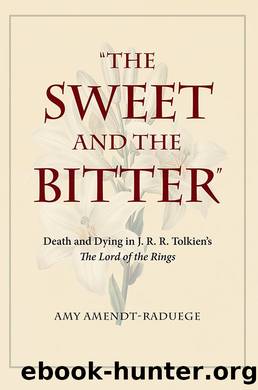âThe Sweet and the Bitterâ: Death and Dying in J. R. R. Tolkienâs The Lord of the Rings by Amy Amendt-Raduege

Author:Amy Amendt-Raduege
Language: eng
Format: epub
Publisher: The Kent State University Press
CHAPTER 4
Haunting the Dead
The dead have long had a hold on human imagination. Archaeologists maintain that the âawareness of death and our attempts to transcend it have haunted humanity for at least the last ten thousand years and probably the last million years.â1 The archaeological record suggests an almost instinctive need to hallow the dead, to dispose of the remains with dignity, and to ensure that their final places of rest are respected. The same need to ensure that the dead rest in peace also connects with an apparently equally instinctive fear of the dead; they can be sources of malevolence, disease, and danger. As a result, our attitudes toward the places of burial are deeply ambivalent. Even the familiar phrase âRest in Peaceâ reflects this ambiguity. On the one hand, it indicates exactly that: a wish that our most beloved departed might indeed rest peacefully in the afterlife, untroubled by the cares and concerns of this world. On the other, however, it means âStay where we put you and donât come back!â2
Just as in the Primary World, the vast majority of the gravesites encountered in Middle-earth are peaceful, serving as symbolic links between the past and the present, the living and the dead. Every so often, however, a grave is not so peaceful, and its societal function as a place of peace and remembrance is disrupted. But these graves, too, are linked to issues of community and immortality, for they are often haunted. Though many âseriousâ ghost-hunters insist that graveyards are rarely hauntedâvery few people actually die in a cemeteryâpopular belief continues to view cemeteries and churchyards as especially haunted locations. Graves represent âfissures in the world through which intimations of immortal damnation can creep,â and in cases where communal unease about a death existâbecause of a tragedy or a murder, for instanceâthe dead are particularly likely to rest uneasily or to manifest themselves to the living until their troubles are resolved.3 The graves of troubled, unusual, or marginalized individuals are particularly susceptible to haunting, and it may be that âadverse circumstances of death may have created âbad deathsâ that required extreme measures often described by archaeologists as âdeviantâ burial practicesâ necessary to keep the unquiet dead in their place.4
For the most part, ghosts are associated with sorrow and tragedy, and while they may not always be evil, they are often disturbing. Why some people become ghosts and others rest quietly remains a mystery, but the prevailing view is that something that happened in this world prevents peaceful entry into the next. One popular view is that âghosts may wander as a punishment to themselves, as in the case of suicides and those who have led evil lives.â5 In his detailed study of the vampire lore of Europe, Paul Barber lists a surprising number of acts that might condemn an individual to an unquiet afterlife, including suicide, murder, death in childbirth, or being conceived during a holy period on the church calendar.6 In the Middle Ages, ideas of the
Download
This site does not store any files on its server. We only index and link to content provided by other sites. Please contact the content providers to delete copyright contents if any and email us, we'll remove relevant links or contents immediately.
In Control (The City Series) by Crystal Serowka(36147)
The Wolf Sea (The Oathsworn Series, Book 2) by Low Robert(35140)
We Ride Upon Sticks by Quan Barry(34441)
Crowbone (The Oathsworn Series, Book 5) by Low Robert(33529)
The Book of Dreams (Saxon Series) by Severin Tim(33307)
The Daughters of Foxcote Manor by Eve Chase(23527)
Trainspotting by Irvine Welsh(21524)
Call Me by Your Name by André Aciman(20380)
The Secret History by Donna Tartt(18865)
Shot Through The Heart (Supernature Book 1) by Edwin James(18855)
The Girl from the Opera House by Nancy Carson(15725)
All the Missing Girls by Megan Miranda(15600)
American King (New Camelot #3) by Sierra Simone(15480)
Pimp by Iceberg Slim(14401)
Sad Girls by Lang Leav(14316)
The Betrayed by Graham Heather(12751)
The Betrayed by David Hosp(12666)
4 3 2 1: A Novel by Paul Auster(12290)
Still Me by Jojo Moyes(11189)
